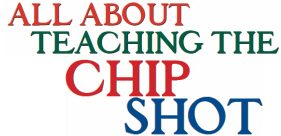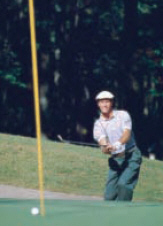All About Teaching the Chip Shot

As with most aspects of teaching golf, unfortunately there seems to be disagreement among teachers about how to teach chipping. For example, some advocate using a wristy
method while others say use no wrists; some teachers believe in using most clubs in the bag for chipping while others say use only one or two.
The fact is that there is merit behind most beliefs. It is up to us to know the pros and cons of each method and when to apply them. If we only teach one way of chipping and insist all students do it this way, we are ignoring the fact that other methods may be more suited to a particular individual. In this article, let’s take a look at basic methodology, different schools of thought, and common swing errors and their fixes.
BASIC METHODOLOGY
No matter what school of thought a teacher may espouse on chipping, almost all agree on one principle: The clubhead should be descending when it hits the ball, with no wrist breakdown through and after impact. The main disagreement is in how this is best achieved.
DIFFERING SCHOOLS OF THOUGHT
The main differences in schools of thought are: 1) using many clubs vs. using few clubs; 2) using a wristy method vs. non-wristy; 3) chipping like you putt vs. chipping with traditional method; 4) ball position forward vs. ball position back.
 1 Using many clubs vs. using few clubs. Teachers who say that you should use many clubs with which to hit chips say that it is imperative to get the ball on the green as soon as possible. They say this promotes the concept of maximum ground time and minimal air time to the ultimate degree. They also say that it provides maximum versatility. Other teachers say that using many clubs is too difficult, because each club has a different feel and each needs to be practiced.
1 Using many clubs vs. using few clubs. Teachers who say that you should use many clubs with which to hit chips say that it is imperative to get the ball on the green as soon as possible. They say this promotes the concept of maximum ground time and minimal air time to the ultimate degree. They also say that it provides maximum versatility. Other teachers say that using many clubs is too difficult, because each club has a different feel and each needs to be practiced.
The verdict is that both are correct. If someone is committed to using many different clubs in their chipping arsenal, they need to practice with every club in the arsenal to get used to the feel of each one. This is recommended if the person has a lot of practice time, such as a touring pro or amateur who has minimal or no work duties, and who truly enjoys the variety of using many clubs. The problem is that most students we teach do not fall into this category. Therefore, it is recommended that most of our students get used to one or two clubs for chipping, and to hit a pitch shot when there is too much distance between the ball and the edge of the green.
2 Using a wristy method vs. non-wristy. Jim McLean and t
he late Jerry Barber promote using the wrists in chipping. Dave Pelz and Ken Venturi say the wrists should be held firm through the stroke. It really doesn’t matter which method is employed, so long as the basic methodology of hitting down on the ball with no breakdown of the wrists through impact and beyond is used. Some players who are too
mechanical might benefit from using a little wrist break on the back swing and into impact, while those who have difficulty making consistent contact will probably benefit from having firmer wrists throughout the stroke.
3 Chipping like you putt vs. chipping with traditional method. To have a student chip like they putt, you would simply have them adopt their putting setup to hit the chip. This would include using a reverse-overlap or cross-handed grip if that’s what they use normally in putting. The only difference is perhaps playing the ball a ball-width or two farther back in order to promote hitting down on the ball. This method, while mechanically simpler, can lack the feel of the traditional method. This method is recommended for beginners, players who don’t have time to practice, or uncoordinated students. Keep in mind, though, that some tour players (who are far from uncoordinated) use this method.
The traditional method involves using an open, narrow stance with most of the weight on the forward foot, ball back in the stance and choking down on the grip. In this method, the weight is usually moved even more forward during and after impact for greater fluidity. The benefit of using this method is it tends to promote greater feel than the putting method, thus its popularity with better-than-average players. The negative is that it can be harder to make good contact, so again, the putting method might be better for this player.
4 Ball position forward vs. ball position back. The majority of teachers say the ball should be back to promote a downward strike. A few teachers, most prominently Stan Utley, say the ball should be forward. Utley’s reasoning is that the ball is forward for regular shots, so it should be there for chip shots. Keep in mind, though, that Utley is a former tour player who works with many t
our players. The ballforward method, if it is used at all, is better suited for advanced players. Most players, even tour players, do favor having the ball in the back half of the stance.
COMMON SWING ERRORS AND THEIR FIXES
Almost all swing errors we see in the chipping game involve 1) scooping with the wrists; 2) hitting up on the ball; 3) swaying the body. There are, of course, setup issues with stances that are too wide or misaligned, but these should be evident and will not be discussed.
1 Scooping with the wrists. This is the most common of all short game errors, also seen in putting, pitching, and bunker play. For chipping there are several drills that have proven effective. One is using a specially-designed chipping club, where we take, say, a 7-iron and cut a hole in the top of the grip and insert a shaft into it. This makes an extended club. Have the student grip the club normally with the extended shaft to the left of their hip (for a righthanded player). They will be conscious of the fact that if they scoop with their wrists, the extended shaft will hit them in the hip, so they tend to make good strokes wit
h this simple training aid.
Another drill involves gripping down so that the butt end of the grip is against the student’s lead forearm. If they scoop when they chip with this drill, the butt end of the grip will separate from the forearm. Have the student focus on keeping the butt end of the grip against the forearm during the stroke. A final drill is to put a second ball about six-toeight inches directly behind the ball to be chipped. If the student scoops, they will likely hit the second ball.
2 Hitting up on the ball. This is different than scooping the ball, which also involves hitting up on the ball. It is not only possible, but common to see someone hitting up on the ball without scooping the wrists. In this case, it is almost the result of the ball being too far forward, the weight being on the rear foot at impact, or both. Simply correct those two faults and hitting up will be a thing of the past.
3 Swaying the body. A golfer who shifts weight back and forth during a chip will likely find great inconsistency, and if they fail to shift the weight forward during the forward stroke, hitting up on the ball is the likely result. A Golf Magazine study showed that the best drill for fixing this problem is to have the student assume a normal chipping stance (with the weight forward), and then take their back foot and place it perpendicularly away from the target line perhaps 18-24 inches (45-60 cm), having only the toe of the shoe on the ground. This will put about 90 percent of the student’s weight on the front foot, and they will find it almost impossible to do anything but keep the weight on the front foot throughout the stroke.
In conclusion, we have seen that there are many effective ways to teach and execute a chip shot. It is important to have a core set of fundamentals that you teach and with which you are comfortable, but it is also important to adjust our instruction if the situation warrants it.




